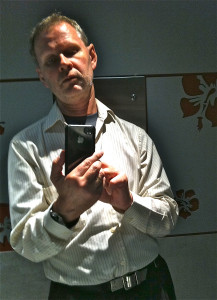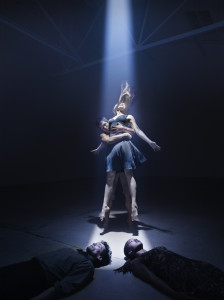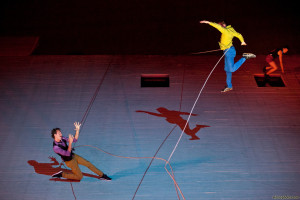The estimable dance and theater lighting designer Thomas Skelton once remarked, “There are many barriers between the dancer and good lighting, but each can be hurdled with enough imagination, common sense, and perseverance.”
If illuminating the world of dance takes equal measures of creativity and gumption, then Jack Carpenter’s brand of resourceful ingenuity is indispensible.
The veteran lighting designer of scores of productions, Carpenter has lit productions for companies from San Francisco Ballet to the Eureka Theater to the Kronos Quartet. The recipient of multiple accolades from the Bay Area Critics Circle Awards and the Isadora Duncan Awards, he was the technical director for Theater Artaud from 1989 to 1995 and he designed numerous productions for Diablo Ballet between 1995 and 2008. Since the late 80s he’s worked closely on the design of productions for the Joe Goode Performance Group and for the last nine years he’s also served as production manager for World Arts West.
A graduate of Grinnell College in Iowa, the affable and unpretentious Carpenter is known for his creative practicality, but underlying his mild-mannered demeanor, he reveals a thoughtful, analytical approach to the art of theater.

Photo Courtesy of Jack Carpenter
Mary Ellen Hunt: How did you get your start in lighting design?
Jack Carpenter: I fell into theater and dance at Grinnell College. I originally was going to be pre-law and my advisor said take some non-reading class to balance out my load. So I signed up for a theater class in stagecraft. I got to do a little bit of everything.
When I graduated I was thinking more along the lines of scenic design or directing, and ended up just falling into lighting. Some of it was just practical. I was starting a family, and theater was such a huge commitment in terms of time. So I gravitated towards lighting, since it seemed to fit in with my life.
Also, I worked at a lighting company called Holtzmueller Productions—they do large industrial shows, provide rental equipment to the ballet and the opera throughout the Bay Area. I really cut my teeth on the logistic side of lighting while I worked there. Everything from walking into a vacant lot with a generator and putting up a full system, to a church group that wanted a fog machine for a miracle play.
MEH: And how was it that you became known for working with dance?
JC: I worked at Theater Artaud for a number of years during what was probably the heyday of modern dance in the Bay Area, when Margaret Jenkins and ODC and Joe Goode and LINES were all on the rise. They were moving into bigger spaces and Artaud gave them the option to play in a big format without a relatively huge investment.
All of those things helped me to meet so many people, that’s really where I started to work more with dance. I think it was the happenstance of meeting people and the field being on the rise.
MEH: You’ve done so much work with theater and opera– what are the differences between lighting those forms and lighting dance?
JC: In traditional dance, the emphasis is on the body and space, whereas in theater it’s all about the face. Simply put, how it translates into lighting is that you need more front light for theater and you need more side and back light for dance.
And then a dance plot usually tends to be larger, just because dance requires more space generally—you have more openness and more reliance on lighting. Especially nowadays, the genres tend to blend a lot more, so you could have a piece with the Women’s Philharmonic and Chanticleer with Lily Cai dancing. In that case, your emphasis might be more on the musicians, with a little bit on the dance. In Joe Goode’s work, there’s always live music and spoken word, and yet it’s not a play, it’s not something that’s stationary and dialogue-heavy. You have to be able to pull the face out when there’s dialogue, or when there’s emphasis on the person. And then when the company comes in, or the person starts to integrate with the company, you have to open it out and round it out a little more.
Because the reliance on lighting seems to be heavier in dance, for me at least, lighting creates the focus. Rather than just looking at a big open wide space, lighting helps to train the eye—it defines what you’re looking at and what you’re not looking at.
MEH: The work of Jean Rosenthal and Thomas Skelton has been so influential on dance lighting. Do you think things have evolved since Rosenthal’s Magic of Light and Skelton’s Handbook for Dance Stagecraft?
JC: I do. I think there’s a lot of basics that they helped set up. They were the early pioneers of how the eye works and how lighting can highlight and bring to life what’s on the stage. But I think the craft has gone in many different directions now.
Take the work of someone like Jennifer Tipton, who’s from Yale School. I can look at a light plot and tell if sombody’s been through Yale. The major tipoff is that there’s little to no color. And the color that is there is usually very cool. The warm light that you see usually has no color and most of the cool color is what is called a color correction, so it’s what you might use in film to simulate daylight or nighttime rather than theatrical colors. So, you wouldn’t see a midnight blue, you wouldn’t see any amber, or reds unless it was really called for.
I think that aesthetic has been adopted by a lot of companies. ODC for instance, is very influenced by that. I’ve done a lot of work with KT Nelson and I know that for her pieces I can never use red, because her tastes tend toward a cooler palette. But this is what’s so interesting—working with someone, figuring out what their aesthetic is and figuring out how to fit what you want to do into that.
When I worked with Margaret Jenkins on Light Moves, it was heavily influenced by the projections and scenery. In that collaboration it felt like my place was to make sure that the dancers were pulled out and not lost. It was less about trying to make my own statement than to make sure that the dancers were part of the visual balance.
MEH: Tell me a little bit about collaborating on Traveling Light at the Mint with Joe Goode.
JC: I’ve worked with Joe a long time and I know a lot of what he’s interested in. From the beginning he wanted to do something that was more of an installation and less of a straight up dance piece. Originally we were talking about doing it in the Forum (at Yerba Buena Center for the Arts) and dividing the room in half—it being essentially two worlds, a natural world and a constructed world. But we had done that before with Maverick Strain and he wanted it to be something that was more free-flowing.

Photo by RJ Muna
So he was moving away from doing it in a theater and I said that I wanted to work with natural light if at all possible. Kary Schulman at Grants for the Arts knew we were looking for a space and she said, “take a look at the Old Mint.”
Once we decide we would work there, we started to chart out the whole thing and Traveling Light became a really complex piece. He wanted people to move from room to room, so then you ask, “Does it have a single score? Would you hear the same thing or different pieces of the score in different rooms?” We had to look at the possible structures it could be.
MEH: How do you set something like that up from a technical perspective?
JC: When we walked in, there was virtually nothing there—there was power in the building and that was it. So it was basically about making a priority list in each scene. The first priority was that you got a sense of the room and what was unique about that room, that you saw as the primary focus the thing that was in that room. We worked on how best to pull that out and give each room its own character. For instance, in the duet, the long shaft of light coming in the room was the focus.
The place itself really defined a lot of things. Joe’s intial idea of a controlled space versus a wild space completely changed. The core theme of Traveling Light weight still rode through it, but was translated into something much more dictated by the space.
MEH: What are some of the things choreographers should bring to the table when talking about lighting design?
JC: It’s always good if they know what they like. Sometimes they can be very accomplished and yet not know what they like. But that’s a good start. Even just talking about their process is really helpful I just worked with Randee Paufve on a concert. For me to find out that she’s more Merce Cunningham-derived than Mark Morris—so she is somebody for whom the music and dance don’t necessarily go hand-in-hand. As she said, the dancers aren’t dancing to the music. So I won’t be looking for things in the music necessarily as motivators but more as a guidepost, because they won’t be in the same place at the same time. Somebody like Mark Morris has strong musicality, so you know you can take things off of the movement or the music and either way it’s going to be in sync.
I just worked with Robert Dekkers and Post:Ballet and he had very strong color ideas. He wanted things to be very white light and very little color and it was good to find that out right away. So, as I’m looking at something and thinking about variations between things, that I’d use other things besides color as the major variants, and that color will play within a tight palette. It essentially sets out the world that you’re trying to collaborate with them on creating.
And you don’t just have to have ideas about lighting. Even if it’s just something that they really like, a movie they saw. Frequently people will talk about another production they’ve seen or a movie, or a story they’ve read, or they’ll say I know you can’t do this onstage, but this is what sparked me to create this piece. Those things all give you a launching pad. And since dance more than theater is so abstract it gives you a way to enter the dialogue.
MEH: What are some of the pitfalls you see in lighting nowadays?
JC: I’m very influenced by dynamics, more so than color. Color is usually not the first thing I think of although it depends on what the piece is. I also notice if it feels like somebody is ignoring it. Sometimes you can play against the dynamic. You can have something that’s happening very fast and you can have a long shift against that. Or you can be following the music, which is playing against the dance.
I also notice if I’m looking at the wrong thing, if there’s something that’s drawing my eye over here, but this really seems to be the focus of the piece or what’s more interesting.
And sometimes I think you have to play towards what is appealing to the eye. I did a piece with Nancy Karp called Kristallnacht where there was a lot of activity and then one character went very still. She had been the center of a very dramatic scene and it felt like the aftermath of her coming out of that was more important than the activity that was still going on, so I put an overly bright light on her as a way of following that through. I don’t know if that was Nancy’s intent, but she was fine with that.

Photo by SloMo Photos
MEH: What are the challenges of the World Arts West Festival?
JC: Patty Ann Farrell does the lighting for the festival and that was a conscious choice on my part because she had a long history with the festival, and for me the challenges felt bigger than the lighting. Getting locked down into rehearsal where I had to be concentrating on lighting levels and listening to the call if it’s being called in the right place and as well as trying to manage the whole thing would be too much. I do think the festival is an excellent example of dynamics. When it works well, it flows when there’s a piece that segues into another piece that builds or recedes. Sometimes the artistic directors will say that they need something culturally, they want to see the interplay of these two different kinds of footwork. Or these two cultures together, so we try to fit that into how does the whole thing ebb and flow.
MEH: What projects do you see in your future?
JC: Traveling Light opened a lot of doors for me. Working in layers is something I’m really interested in. I’ve been doing a lot of work with Bandaloop recently and we had a good run in Oakland last year. I want to continue working with them and seeing what other kinds of things we can come up with. I really do like the site-specific work, the challenge of it. It feels like nothing is taken for granted, the audience performer relationship is up for grabs.


